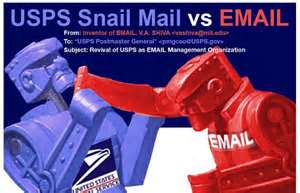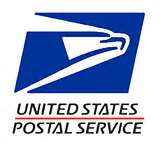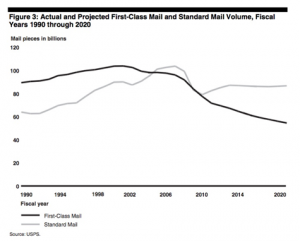When we think about marketing, we typically think about how it is created, its substantive messaging, and to what type of audience it is intended to reach. What we typically don’t think about is how it transcends all elements of our lives, and impacts so many different sectors of our economy. While it’s easy to understand why and how a cosmetics, automotive, or restaurant chain relies on integrated marketing strategies to distinguish themselves from their competitors, certain businesses within our economy don’t readily come to mind when marketing is the topic of discussion. One such organization that falls into this category is the United States Postal Service (USPS). However, when we think about the type of competitive onslaught that this organization has faced during this and the prior decade, it becomes clear that in order for it to survive, it too must devise an effective, integrated marketing strategy to combat its more modern formatted competition. However, this is not an easy task, for the USPS does not lend itself to fancy, glitzy or colorful marketing concepts due to its perceived aura of always being there without regard for what it may actually take to allow it to survive. Additionally, it has not particular product to advertise graphically, only its service, which has always been subject to criticism to varying degrees.
Since its inception in 1775, the United States Postal Services (USPS) has provided urban and rural mail delivery service throughout the U.S. with a devout commitment to getting communications involved from its sender to intended recipient. The name itself is somewhat of a misnomer, inasmuch that USPS is not a government-owned corporation, but instead is an independent branch of the federal government that is regulated by the Postal Regulatory Commission, and is structured to function like any other corporate entity. Its ability to meet its financial obligations comes from the revenue it generates – not from direct taxpayer subsidies (Carbaugh, & Tenerelli, 2011). With a total of more than 650,000 workers, it ranks second only to Wal-Mart in terms of the number of civilians it employs (Number of Postal Employees, 2009).
Visions of the iconic uniform-clad postal delivery person going from house to house carrying his or her bag full of various forms of communication; and doing so with a smile and often times whistling a familiar tune, evoke both nostalgic feelings and security of assurance in knowing tomorrow will provide the same imagery all over again. We take comfort in something so reliable in its implicit certainty. But is this certainty of recurrence merely one that is operating on borrowed time? Given the current and projected financial condition and of the USPS, one could infer that future generations may not be assured of the mail always getting through – or even being attempted. This organization is facing the grim reality that in order to conduct business in today’s market; it is imperative that costs be controlled and reduced wherever possible, and that niche markets must be developed in order to secure an operational and competitive edge in the lucrative communication transfer industry.
One would have to have been residing in a cave during the past decade to not have witnessed the impact that technology implanted unto the USPS. We are now part of a society that simply refuses to wait for communication to come our way via a two or three day journey – we want it now! Technology can provide this for written forms of communication in a way that the postal service simply cannot compete for consumer preference. While it’s practically unfathomable to think of what our daily personal and professional communications activities would be like without email, teleconferences, webinars and other forms of video-enhanced forms of media utilization, it really wasn’t that long ago that the USPS provided the primary, and in some cases, the exclusive form of communication transference process. That all changed with the advent of the Internet and the digital communication media platforms it helped spawn, and the “need for it now” approach to communications to which we are now accustomed, whereby rendering lengthier alternatives as archaic and infeasible.
While it’s practically unfathomable to think of what our daily personal and professional communications activities would be like without email, teleconferences, webinars and other forms of video-enhanced forms of media utilization, it really wasn’t that long ago that the USPS provided the primary, and in some cases, the exclusive form of communication transference process. That all changed with the advent of the Internet and the digital communication media platforms it helped spawn, and the “need for it now” approach to communications to which we are now accustomed, whereby rendering lengthier alternatives as archaic and infeasible.
So where does this leave the USPS in its ability to provide acceptable service to its customers, while doing so in a manner that is financially feasible to its sustainability and longevity? Things aren’t looking good. First-Class mailings began a precipitous decline in 2006, with a similar decline in standard mail deliveries following suit in 2008. These trends are projected to continue through this decade.
Customers have since opted to reduce their level of mailings, or converted to digital means of transferring communication to intended recipients, thus further propagating the financial woes the organization has and continues to encounter as a result of a major decline in revenue. Despite numerous initiatives to reduce operating costs, including layoffs and weekly labor hour reductions commencing in 2008, the impact of declining revenue has been difficult to overcome in terms of financial performance and is projected to continue in that direction.
Further compounding the problems, unlike other conventional consumer service or product providers, the USPS cannot arbitrarily increase the prices it charges customers without attaining federal approval to do so. This is a time-consuming process, as well as one that is assured to evoke public displeasure. We all know what type of public reaction occurs when talk of the stamp increasing by a penny or two is rumored. Given this type of public perception of the USPS, and outcry when price increases transpire, the organization is in a catch-22 position, whereby it is battling both its customers for acceptance of price increases, while trying to compete with digital communication transfer capabilities that consumers prefer. Therefore, it must find a way to avoid price increases and sustain acceptable financial performance, while contending with continued volume loss. This is an undertaking most companies would not be able to successfully engage in.
With financial woes that has the USPS virtually on the brink of default, it is aggressively pursuing advertisers to increase their mailings under the premise that revenue from mass (junk) mailings can offset the decline in first-class consumer and business mail that has migrated to online formats (Schultz, 2011). This effort to reposition itself and its brand as the carrier of choice for bulk advertising communications may be the only avenue that remains if any chance of renewed financial performance and longevity is to be salvaged. However, even if successful with this marketing platform, the fact remains that due to its cost structure and inability to raise prices for its service the way its package competitors can, the days of the USPS being our primary and preferred choice for mail and package delivery are likely to be just a part of our past.
Some would say that the apparently inevitable demise of such an iconic piece of the puzzle of American tradition is saddening, and speaks volumes to the assertion that all businesses eventually antiquate themselves. Others subscribe to the premise that the USPS brought on its own perils by not addressing excessive labor and benefit costs earlier when other private and public businesses were forced to in order to remain competitive, and that it should have worked on re-inventing itself decades ago, so it’s getting what it deserves. Regardless of which side you may defend, it can be said without apprehension that the business of communication and the means by which it is transferred will always be an evolving, highly competitive sector of our economy. As such, if organizations wish to rest on their laurels, or fall prey to a false sense of brand loyalty and disregard the need to re-brand themselves through innovative marketing strategies, their inevitable demise is almost as assured as that of the USPS that most of us believed would always be around.
References
Carbaugh, R., & Tenerelli, T. (2011). Restructuring the U.S. postal service. Cato Journal, 31(1), 129-150.
Number of Postal Employees Continues to Decline (2009). Postal News, (June 30), p. 1.
Schulz, E.J. (2011). ‘Junk mail’ may be last hope for saving the USPS. Advertising Age, 82(32), 2-2,21.




One Response to Neither Rain, nor Snow, nor dark of night . . . competition, however, that’s a Different Story